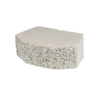So once the final grade is determined…what is the best way to “Begin” a stacking retaining wall?

trench then fill then stack? thanks cale
So once the final grade is determined…what is the best way to “Begin” a stacking retaining wall?

trench then fill then stack? thanks cale
Cale Nelson said:
So once the final grade is determined…what is the best way to “Begin” a stacking retaining wall?(http://images.lowes.com/product/converted/742786/742786300010sm.jpg)
trench then fill then stack? thanks cale
Keep it under 4 feet high. Any higher and you need an engineer to sign off. Ralph
Aside from the link that HJ gave… First, determine where and how high the wall is to be… 1. Trench out for the foundation… 2. Fill with a base material,
Andy is only showing you a few of “THE GREAT WALLS OF NASHVILLE, ILLINOIS”. You can ask him questions, he’s learned most of the lessons. 
thanks guys, I’d venture the highest mine will be is less than 3’…
Andy stay close!
Cale - If those are (and you will be using) the Castle Wall blocks, they have a lip along the back edge that automatically creates a backward step.
(http://www.myoldcastle.com/images/products/medium/castlewall2.jpg)
They also drain quite well between the blocks. I used them to build a wall for a parking pad in the back yard last fall. I did spend a lot of time getting the first course exactly right, but I neglected to install drainage behind it. That worried me after I read how to do it correctly, but I’ve notice during heavy rains that the wall joints are very porous - water doesn’t tend to collect behind it (so far anyway). You do want to be sure that the first course is mostly buried. Old Castle has a pretty good set of DIY instructions on their website. http://www.myoldcastle.com/Products/Hardscapes/wallsdetails.htm?ind=3
If your only going 3 foot high, and Jon says that the wall drains well, you might not need a drain pipe behind the wall… That’s your choice… The link that Jon has got some good instructions, however, when backfilling behind the wall, I would use some rock covered with landscaping fabric, to insure drainage… The instructions say to use sand… I wuld have a tendency to believe the sand would migrate thru the bricks, along with the water… The main thing you don’t want, is water stuck behind the wall, cause when and if it freezes, water expands…
You better do it NOW…and not realize in 10-15 years , that you should have !
The pipe and rock and fabric is good insurance .
Cale as a landscaper who builds walls all the time here’s some basics for a 3’ wall
1 - Base material (compacted gravel - the stuff used for roadways) 8-12 inches
2 - one course of wall should be below finised grade
3 - backfill with #2 STONE not sand - the angled stone, not round stone COMPACTED
4 - used an approved fabric between the soil and #2 stone
If you compact the backfill stone properly it actually is what retains anything behind it and the blocks then become a “pretty facia”
If you don’t compact the backfill the weight of the setback and wall pushes one way the earth on the backside pushes the other, resulting in a crooked wall eventually
The reason you burry one course is to make sure the bottom of the wall doesn’t eventually kick out and collapse the wall.
remember anytime you use sand or a product with “fines” is that they eventually will erode, that’s why you use a base material with larger angular stone that lock together when compacted. eventually that’s what the wall will be resting upon.
Don’t, and I mean DON"T rush getting the base material compacted and level as you can before you even think about setting blocks
Andy Clarke said:I'd agree with that. I didn't use sand, but just compacted dirt behind it. Yes - the silt does migrate through the wall, so some rather large stone (3/4 or bigger) covered by landscape cloth would give you the drainage without the silt.
[i][/i] when backfilling behind the wall, I would use some rock covered with landscaping fabric, to insure drainage... The instructions say to use sand... I wuld have a tendency to believe the sand would migrate thru the bricks, along with the water... The main thing you don't want, is water stuck behind the wall, cause when and if it freezes, water expands....
The other problem besides freeze/expansion is hydraulic pressure. That’s why I suggested that the first course be mostly buried. I was about half done with my wall and a short section near the end was built up under the first course rather than adding a new course below. The first rain proved what a mistake that was. Water pressure kicked out the bottom block and about 1/3 of my fill went down the hill to the neighbor’s yard with the water.
EDIT: I just read Mark’s post. Agree 100%